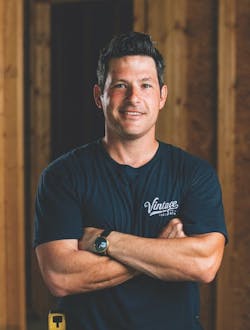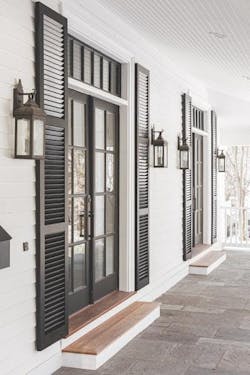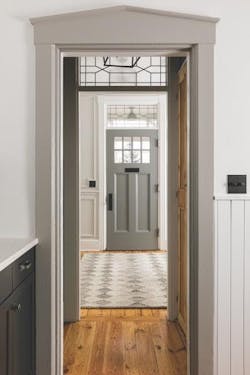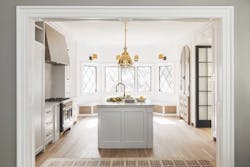Q + A: The Art of Craft
John Hourihan
Founder
Vintage Builders
John Hourihan is the founder of Vintage Builders and co-host of the popular podcast “The Modern Craftsman.” His design philosophy is to take the solid proportions and designs from the master builders of the past and mix them with modern amenities. Vintage Builders was born from a love of traditional building techniques and the desire to cultivate meaningful relationships with clients, the builder says. He recently sat down for a chat with Custom Builder.
When did you realize that construction is where your heart is?
Probably when I watched Fraggle Rock on TV for the first time and saw the little guys that built on the ground. You know, they kept getting stuff smashed. And they kept building it right back up. That was kind of my moment, I think, when I was young. Then I worked for a remodeler when I was 16, and I fell in love with it. After that I was working at a hockey rink and I’d bring home hockey sticks that were broken and I’d build hockey stick furniture in my basement while watching
This Old House.
How can builders balance managing expectations while harnessing the power of social media and home building reality TV?
HGTV is a blessing and a curse because it gives a false sense of timing and budget. You don’t know the scale of the room the photos were taken in or the time of day. It’s about having boundaries and understanding them and just knowing what you can and can’t do.
But we do a lot of design based on the client handing me a photo, saying, “Hey, can you give me this laundry room?” I’ll search my photos or social media or Houzz, and I’ll find something that’s close. I have a client who wants to do a cedar roof, maybe a tin roof. So I sent her a bunch of images of houses that were very similar to what we were thinking. She said, “You know what? I think tin is too farmhouse. I want country.” So we decided on all cedar. Social media is a good reference point because you can verify ahead of time and not have to wait until someone starts to realize that that idea or material isn’t right.
Where did the name Vintage Builders
come from, and how does it represent
your particular design style?
“Vintage Builders” came to me in 2015. That exact design you see on our logos? I hand-sketched that one night over a beer. The inspiration came from the small one-off companies that really have a good connection with their clients.
Vintage isn’t just a kind of style of home we build with certain details; it’s also having that [old-time approach to] customer service, seeing a house as its own individual product, not a mass-produced thing.
I grew up in New England, and we pulled details from houses that are hundreds of years old. We’re trying to take historic, accurate details and bring them into houses that get built today. So, when you look at an old home and think, I wish I could live there, and then you think about the drafts, inefficiencies, what was put in that house for insulation, or lack of, and not having Wi-Fi and not having enough plugs … . We style that house—same character details and beauty—but with all of the cool, modern stuff.
So you’re able to have your cake and
eat it, too.
Yeah, damn right. And, honestly, we should. If I have 25 years’ experience, why shouldn’t I use that? It’s my responsibility to use that and give that to my client and my build. The client might do this once in a lifetime; I do this every day for a living. So they should get the best part of every piece of experience I have: craftsmanship, details, architecture ... all that is important to every single piece of that house.
What are some things we can learn from builders of the past?
The biggest thing to be learned from older houses is definitely proportion and scale. Things that look right to the human eye, like a flower, are beautiful.
The proportions on older homes were done well because there were professionals called master builders. That’s a title I’d like to have at some point. I don’t know how you get that title. Who deems you that? Is it like being knighted, where you lay a sword on my shoulders and say, You are now a master builder.
As a master builder, you did both ... you designed and you built, and you had these pattern books that were your go-to for all of these little details. And that’s basically what we do now: We build houses with a lot of the same details derived from older homes that have the right scale, the right proportions.
How can a custom builder add the vintage touches you do without it looking contrived or out of place?
The simplest way is to hire an architect or a designer to kind of kick up the outside for details. The other way is to look up old architectural pattern books. I love turning pages that craftsmen before me have also turned. A lot of books give you great references on proportions, windows, baseboards, chair rails, how to do soffit and fascia corner boards ... . All that stuff is being lost. Looking at pattern books was how I learned about proportion, scale, and all that.
Could you talk about why it’s important to match the tone of the neighborhood?
As a builder, our job is to make something that fits its surroundings. It’s like you have two circles: the circles you can control, and the circle that is the environment around it.
Here’s an example: We take the heights of all of the neighboring homes’ foundations and then average them so we know where the top of our wall should be. On one of our projects, the goal behind doing that was to make it look like our house was there first and everything else was built after it.
So, where can we pull inspiration from? Well, how about the library in town? Or the country club, which is Greek Revival and has a massive gable end that reminds me of the clock tower in the movie Back to the Future.
We are leaving our stamp on this earth, and that neighborhood changes around us. If I build a house and another builder comes along and wants to build something, I want that builder to appreciate the character of our build and to draw inspiration from it—as well as from the neighboring homes. I want to make sure we didn’t set the wrong tone for years to come.
If you were custom building your own
home, what features or styles would you use?
We like old country homes, and I love imitating the old bones of a house. We put in a lot of reclaimed wood, authentically done, meaning it should look like it carries a load and a beam. We have an old house in a tiny little town. I love an old farmhouse. But I mean a real farmhouse, not today’s farmhouse, not the white farmhouse with black-trim windows, but an old-school farmhouse with brick and lots of different textures. It tells a story. The home wouldn’t have a mudroom. And it would have a very small kitchen. But as it expanded, it would have a garage and a laundry added on with different materials, with shiplap, or brick, or clapboard, and it would tell the story of the evolution of that house.
Did I answer that right?
There’s no right or wrong!
Well, it’s tough. We try to design homes that fit around families and can grow, versatile rooms where kids can be kids, but then as they grow up to be young adults, the house still works for them.
I think that’s what I’d want to accomplish in my house if I could. If you do it right, you can build a big house, but it’s still cozy in every room. And each space should bring back a memory. Say we’re designing a powder room, and you once went to a café in Brooklyn, New York, and you loved its bathroom. Well, let’s redo that here. We’re not cutting and pasting, we’re using that as inspiration. So when you walk into that space, it’s not just a bathroom, it’s a memory that takes you back in time.
What are you currently obsessed with?
Honestly, it’s absolutely always design. That’s what challenges you. The goal is never to build just to the code, that’s the minimum standard. The goal is to build something that’s going to last for 100 years or longer, just like our ancestors used to build.
I’m obsessed with understanding what are the most authentic materials we can use that will also last the longest and give us the best results every day, and they’re always changing, and sometimes they fool us and they don’t really produce what we want or they don’t hold up. It’s trying to create the designs we want, where we won’t have to go back and maintain them as much or worry about how they’re going to age.



